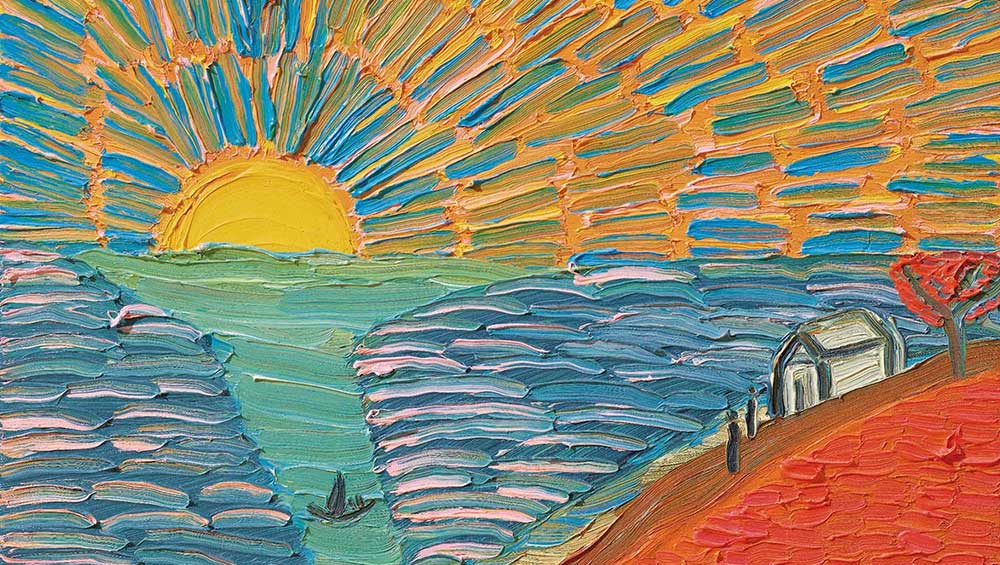
Matthew Wong, The Journey Home, 2017 (detail). Private Collection, Courtesy of HomeArt. © Matthew Wong Foundation c/o Pictoright Amsterdam 2023
Van Gogh Museum, Amsterdam
1 March – 1 September 2024
by BETH WILLIAMSON
Nothing quite prepares you for the vibrancy of the paintings by artist Matthew Wong (1984-2019). Even up against the best of work by Vincent van Gogh (1853-90), one of many artists in whom he found inspiration, Wong’s work glows and shimmers with a depth and vitality of colour that has no clear comparators. And therein lies the rub with Wong. There is no single comparator, not even Van Gogh. Yet, it was Van Gogh that the Chinese-Canadian artist felt an affinity to, artistically and personally, and that affinity is at the heart of this exhibition. In 2018, Wong said: “I see myself in him. The impossibility of belonging in this world.”1 Wong recognised Van Gogh’s struggles in himself, trying to carve out an artistic career while dealing with the mental turmoil of depression and other difficulties (Wong was autistic and had anxiety and Tourette’s syndrome). Both artists were self-taught and, coincidentally, painted their first picture aged 27. Tragically, both also died at a young age.
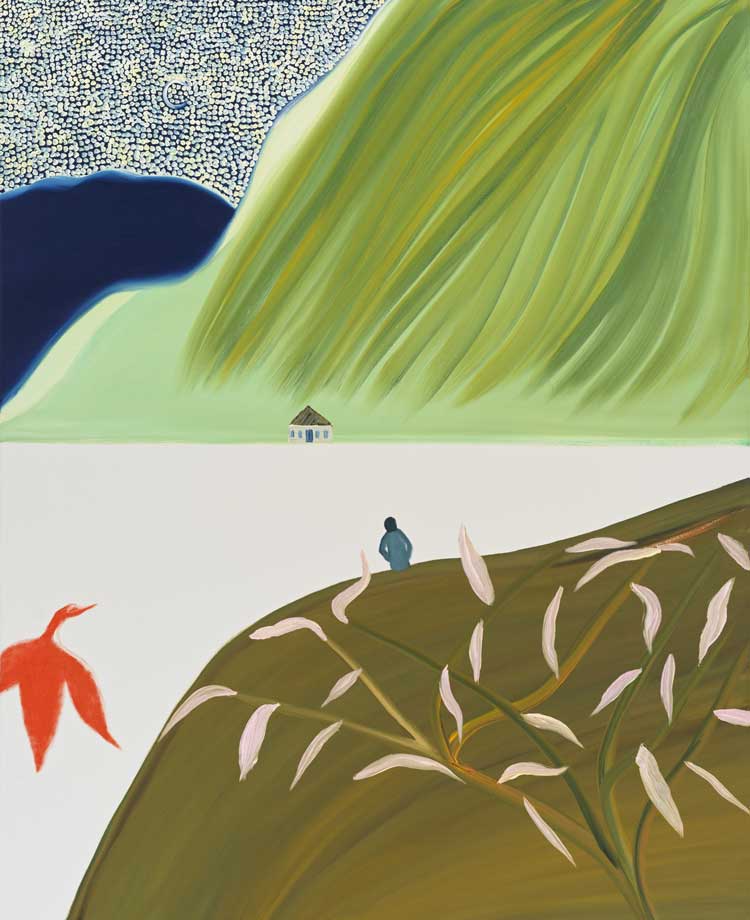
Matthew Wong, See You on the Other Side, 2019. © 2023.Matthew Wong Foundation / c/o Pictoright Amsterdam 2023.
The exhibition is one in a series that began at the Van Gogh Museum in 2022 when work by the Lebanese-American artist and poet Etel Adnan (1925-2021) was shown alongside that of Van Gogh. Director Emilie Gordenker’s aim is to show Van Gogh’s continued legacy for contemporary artists and, in so doing, to present fresh perspectives of the collection. That is certainly the case with Wong, an exhibition researched and curated by Joost van der Hoeven. Curator and director alike are clear that this is not a “compare and contrast” exhibition, something that is underlined by the fact that there are only six works by Van Gogh and more than 60 by Wong.
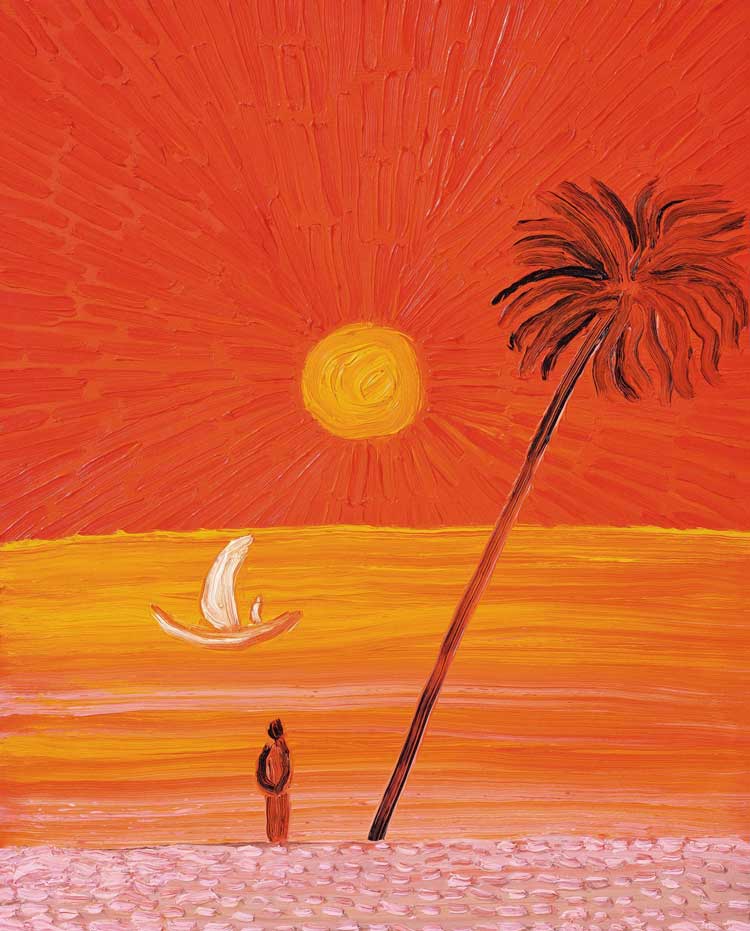
Matthew Wong, The Journey Home, 2017, Private Collection, Courtesy of HomeArt © Matthew Wong Foundation c/o Pictoright Amsterdam 2023.
Van Gogh was a major influence for Wong, but he was not the only one. Wong was a voracious reader of online texts and researched his artistic interests there. He discussed art with friends online too. In one exchange with his friend the artist Peter Shear in 2015, Wong seemed to sympathise with Van Gogh’s difficulties but admired his tenacity. Wong had tenacity, too, trying a number of different paths through life and work before settling on painting as a last resort in 2011. This was, he felt, his last chance to achieve something of success in his life. That success came quickly and by 2017 he was represented by the New York gallery Karma. In 2019, barely eight years after making his first drawing, Wong took his own life.
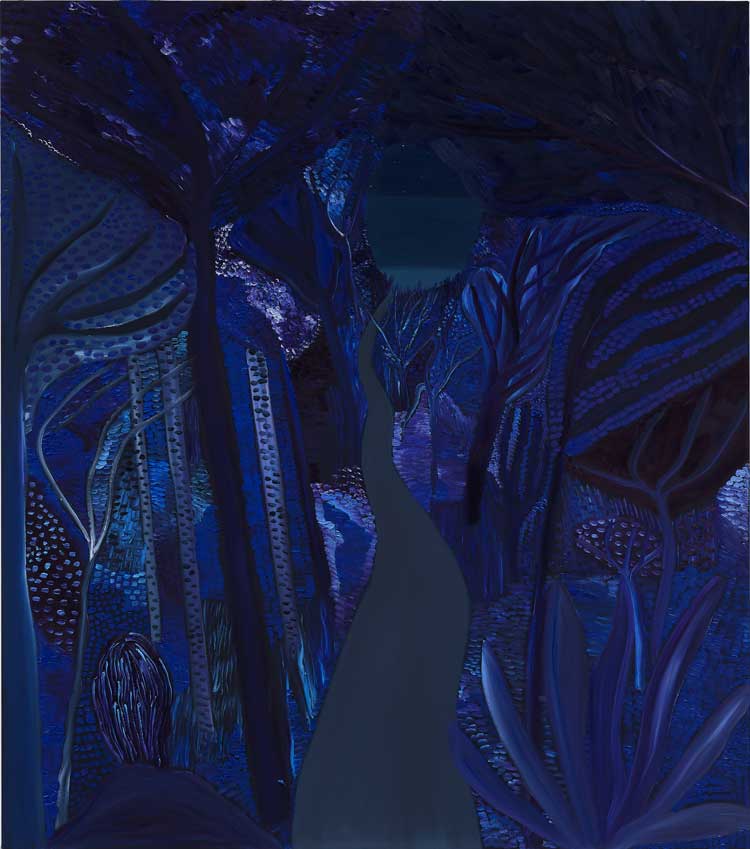
Matthew Wong, Path to the Sea, 2019. © Matthew Wong Foundation c/o Pictoright Amsterdam 2023.
This is Wong’s first retrospective in Europe and the first opportunity for his work to be shared with wider audiences. Extending over three floors of the museum’s gallery spaces, Wong’s work is exuberant and mystical. It is deeply melancholic and the intensity of colour is quite astonishing. Wong’s colours seem to come from somewhere deep inside the picture, which makes sense when you realise that he painted from inner necessity. His use of indigo, blue and violet are especially emotive, and paintings such as Blue Rain (2018), Path to the Sea (2019) and Solitude (2018) are imbued with an aching sense of deep welling loneliness. Even among the fiery crimson, gold and orange of paintings such as The Journey Home (2017) or the phenomenal The Realm of Appearances (2018), the presence of a tiny singular figure often almost hidden among the brushstrokes, Wong’s loneliness reverberates like a dampened gong, rich and resonant but diminishing in intensity as our eye repeatedly finds and loses the figure among the colour and materiality of paint laid on the canvas. As he explained it himself: “I do believe that there is an inherent loneliness or melancholy to much of contemporary life, and on a broader level I feel my work speaks to this quality in addition to being a reflection of my thoughts, fascinations and impulses.”2
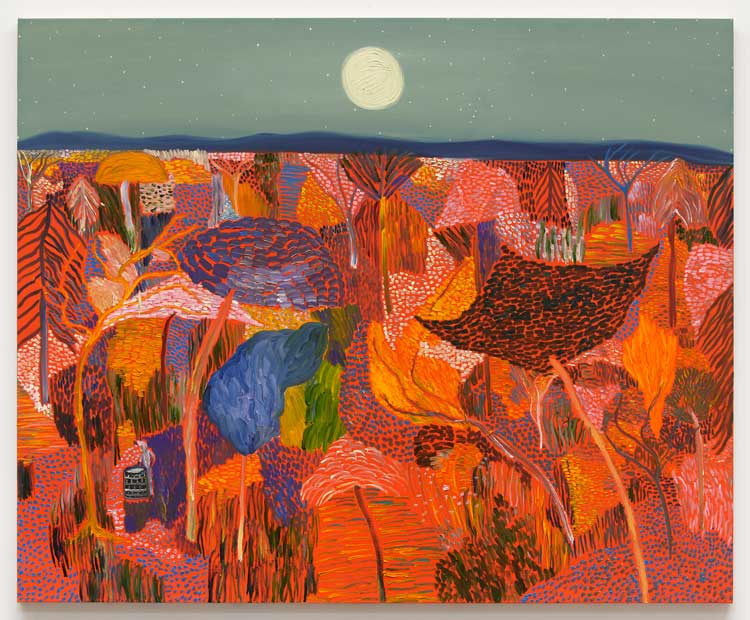
Matthew Wong, The Realm of Appearances, 2018. Private Collection. © Matthew Wong Foundation c/o Pictoright Amsterdam 2023.
One crucial difference between the two artists was that Wong worked from his inner imagination while Van Gogh worked from nature. Wong educated himself in Chinese, European and American art history and, to begin with at least, embraced the traditional artistic materials of his Chinese heritage, using ink on rice paper in drawings that were resonant of American abstract expressionism. He often tried out ideas in ink before moving to paint. When it came to painting colour, Wong’s handling was intuitive, creating dreamscapes and imaginary worlds in which he and his viewers could lose themselves.
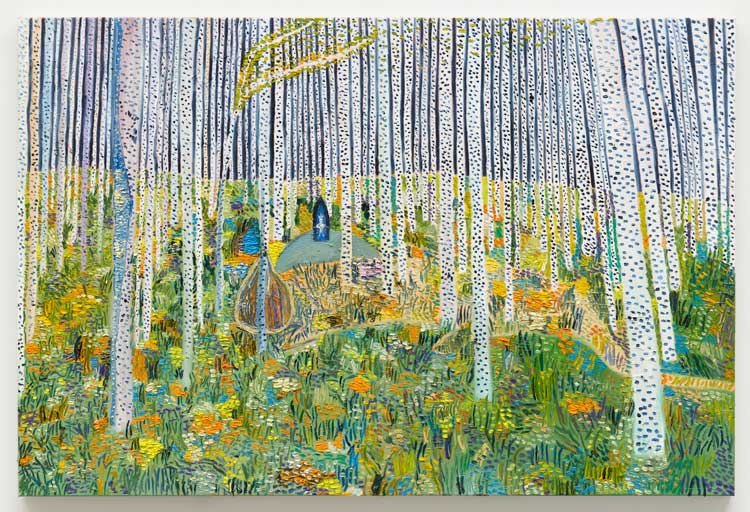
Matthew Wong, The Kingdom, 2017. Collection of Liz Lange and David Shapiro. © Matthew Wong Foundation c/o Pictoright Amsterdam 2023.
Thinking about the impact of Van Gogh and other artists in his life and work, these different strands of influence can appear individually or in multiple parts in a single painting. In a painting such as The Kingdom (2017), Wong’s multicoloured birch forest shows shades of Van Gogh, David Hockney (b1937) and Gustav Klimt (1862-1918). It also recollects the birch forests around Edmonton in Canada where Wong lived for the last three years of his life. There are echoes of other artists throughout his work too. Nostalgia (2016) may have Van Gogh at its colourful core, but The Scream (1893) by Edvard Munch (1863-1944) hangs like a deathly shadow across it. The stippled colour of Wong’s Bright Moment (2016) takes its cue from Yayoi Kusama (b1929) and his wild painterly abandon in works such as Untitled (2014) and others gestures to the likes of Willem de Kooning (1904-97) and Joan Mitchell (1925-92). Wong’s strategy with these artist and others as diverse as Henri Matisse (1869-1954), Milton Resnick (1917-2004) and Shitao (1642-1707) was to study their work intensely for a short period.
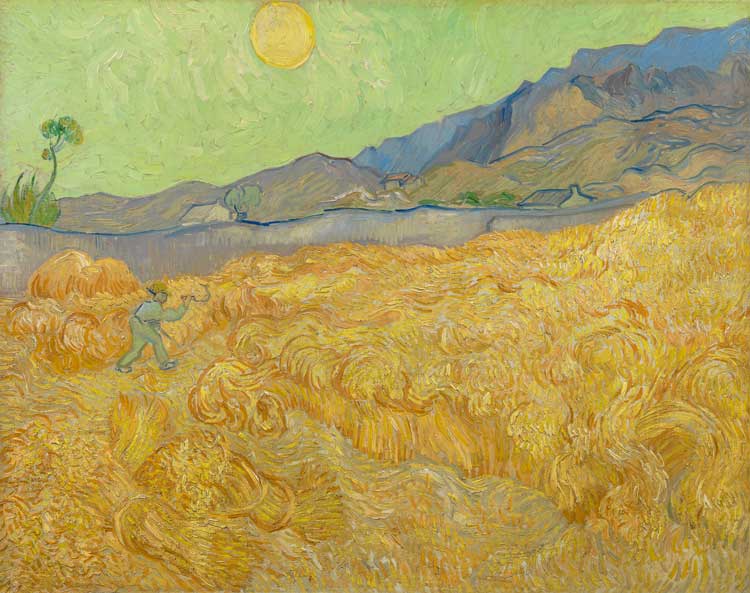
Vincent van Gogh, Wheatfield with a Reaper, 1889. Van Gogh Museum, Amsterdam (Vincent van Gogh Foundation).
His interest in Van Gogh, however, was more enduring and sustained him throughout his artistic career. Some very direct comparisons can be made, say between Van Gogh’s Wheatfield with a Reaper (1889) and Wong’s Coming of Age Landscape (2018). Yet, it is the scope and extent of Wong’s influences that really dazzles. There are more oblique refences to artists such as Adnan and Francis Bacon (1909-92), for example, and others mentioned in the exhibition texts and monograph. As someone who was such an insatiable online researcher of art and art histories, it is, of course, difficult to know where all Wong’s influences originated. The research for this exhibition rightly brings Van Gogh to the fore. It also shows how Wong used his understanding of other artists, too, to develop a unique aesthetic approach that dazzles still. For the curious visitor, a temporary display, Landscapes of Sentiment, elsewhere in the museum allows it to share some of its permanent collection and draw out other possible connections with artists such as Paul Signac (1863-1935), Charles Guilloux (1866-1946) and Odilon Redon (1840-1916).
The beautifully sensitive film that has been made to accompany Wong’s exhibition provides the perfect context for those of us unfamiliar with his work until now. A lavishly illustrated catalogue, full of in-depth essays and interviews is a wonderful publication with which to reflect further on Wong’s work too. At the very top of the exhibition, on the third floor, Wong’s wonderful painting Path to the Sea (2019) is hung in solitude and can be viewed in meditative quiet. It is an opportunity not to be missed.
References
1. Matthew Wong quoted in Van Gogh Museum press release for Matthew Wong | Vincent van Gogh: Painting as a Last Resort.
2. Matthew Wong quoted in Mathew Wong | Vincent van Gogh: Painting as a Last Resort. Edited by Joost van der Hoeven, published by Tijdsbeeld Publishing, Ghent, 2023, page 105.
• Landscapes of Sentiment is at the Van Gogh Museum, Amsterdam, until 23 June 2024.